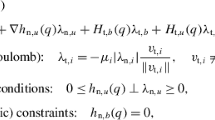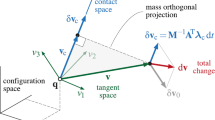Abstract
In this paper, we study the problem of predicting the acceleration of a set of rigid, 3-dimensional bodies in contact with Coulomb friction. The nonlinearity of Coulomb's law leads to a nonlinear complementarity formulation of the system model. This model is used in conjunction with the theory of quasi-variational inequalities to prove for the first time that multi-rigid-body systems with all contacts rolling always has a solution under a feasibility-type condition. The analysis of the more general problem with sliding and rolling contacts presents difficulties that motivate our consideration of a relaxed friction law. The corresponding complementarity formulations of the multi-rigid-body contact problem are derived and existence of solutions of these models is established.
Similar content being viewed by others
References
A.M. Al-Fahed, G.E. Stavroulakis and P.D. Panagiotopoulos, “A linear complementarity approach to the frictionless gripper problem”,The International Journal of Robotics Research 11 (1992) 112–122.
J.P. Aubin and H. Frankowska,Set-Valued Analysis (Birkhäuser, Boston, 1990).
D. Baraff, “Issues in computing contact forces for non-penetrating rigid bodies”,Algorithmica 10 (1993) 292–352.
R.C. Brost, “Analysis and planning of planar manipulation tasks”, Ph.D. Thesis, School of Computer Science, Carnegie-Mellon University, Pittsburg (1991).
D. Chan and J.S. Pang, “The generalized quasi-variational inequality problem”,Mathematics of Operations Research 7 (1982) 211–222.
R.W. Cottle, J.S. Pang and R.E. Stone,The Linear Complementarity Problem (Academic Press, Boston, MA, 1992).
M.A. Erdmann, “On motion planning with uncertainty”, M.S. Thesis, Department of Electrical Engineering and Computer Science. Massachusetts Institute of Technology, Cambridge, MA (1984).
M.A. Erdmann, “On a representation of friction in configuration space”,International Journal of Robotics Research 13 (1994) 240–271.
B. Faverjon and J. Ponce, “On computing two-finger force-closure grasps, of curved 2D objects”,International Conference on Robotics and Autonation, Sacramento, CA (1991) 424–429.
M. Frank and P. Wolfe, “An algorithm for quadratic programming”,Naval Research Logistics Quarterly 3 (1956) 95–110.
A.W. Ingleton, “A problem in linear inequalities”,Proceedings of the London Mathematical Society 16 (1966) 519–536.
A. Klarbring, “A mathematical programming approach to three-dimensional contact problems with friction”,Computational Methods in Applied Mechanics and Engineering 58 (1986) 175–200.
A. Klarbring, “Mathematical programming and augmented Lagrangian methods for frictional contact problems”, in: A. Curnier (ed.),Proceedings Contact Mechanics International Symposium (Presses Polytechniques et Universitaires Romandes, 1992) 409–422.
A. Klarbring, “Mathematical programming in contact problems”, Chapter 7 in: M.H. Aliabadi and C.A. Brebbia (eds.),Computational Methods in Contact Mechanics (Computational Mechanics Publications, Southampton, 1993) 233–263.
A. Klarbring and G. Björkman, “A mathematical programming approach to contact problems with friction and varying contact surface”,Computers & Structures 30 (1988) 1185–1198.
J.C. Latombe.Robot Motion Planning (Kluwer Academic Publishers, 1991).
P. Lötstedt, “Coulomb friction in two-dimensional rigid body systems”,Zeitschrift für Angewandte Mathematik und Mechanik 61 (1981) 605–615.
P. Lötstedt, “Mechanical systems of rigid bodies subject to unilateral constraints”,SIAM Journal on Applied Mathematics 42 (1982) 281–296.
Z.Q. Luo, J.S. Pang, D. Ralph and S.Q. Wu, “Exact penalization and stationarity conditions for mathematical programs with equilibrium constraints”,Mathematical Programming (to appear).
K. Lynch, “The mechanics of fine manipulation by pushing”,International Conference on Robotics and Automation, Nice, France (1992) 2269–2276.
M. Marques.Differential Inclusions in Nonsmooth Mechanical Problem: Shocks and Dry Friction (Birkhäuser Verlag, Basel, 1993).
J.J. Moreau, “Unilateral contact and dry friction in finite freedom dynamics”, in: J.J. Moreau and P.D. Panagiotopoulos (eds.)Nonsmooth Mechanics and Applications, CISM Lectures No. 302 (Springer Verlag, Vienna, 1988) 1–82.
P.D. Panagiotopoulos and A.M. Al-Fahed, “Robot hand grasping and related problems: Optimal control and identification”,International Journal of Robotics Research 13 (1994) 127–136.
J.S. Pang, “Complementarity problems”, in: R. Horst and P. Pardalos (eds.),Handbook on Global Optimization (Kluwer Academic Publishers, Dordrecht, The Netherlands, 1995) 271–338.
J.S. Pang and L. Qi, “Nonsmooth equations: Motivation and algorithms”,SIAM Journal on Optimization 3 (1993), 443–465.
J.S. Pang, J.C. Trinkle and G. Lo, “A complementarity approach to a quasistatic rigid body motion problem”,Computational Optimization and Applications 5 (1996) 139–154.
L. Paoli and M. Schatzman, “Mouvement à un nombre fini de degrés de liberté avec constraintes unilatérales: Cas avec perte d'énergie”,Mathematical Modelling and Numerical Analysis 23 (1993) 673.
V.T. Rajan, R. Burridge and J.T. Schwartz, “Dynamics of a rigid body in frictional contact with rigid walls”,IEEE International Conference on Robotics and Automation, Raleigh, NC (1987) 671–677.
S.M. Robinson, “Some continuity properties of polyhedral multifunctions”,Mathematical Programming Study 14 (1981) 206–214.
W. Seyfferth and F. Pfeiffer. “Dynamics of assembly processes with a manipulator”,Proceedings of the 1992 IEEE/RSJ International Conference on Intelligent Robots and Systems, Raleigh, NC (1992) 1303–1310.
J.C. Trinkle, J.S. Pang, S. Sudarsky and G. Lo, “On dynamic multi-rigid-body contact problems with Coulomb friction”,Zeitschrift für Angewandte Mathematik und Mechanik (to appear).
Author information
Authors and Affiliations
Corresponding author
Additional information
The research of this author was based on work supported by the National, Science Foundation under grants DDM-9104078 and CCR-9213739.
The research of this author was partially supported by the National Science Foundation under grant IRI-9304734, by the Texas Advanced Research Program grant 999903-078, and by the Texas Advanced Technology Program under grant 999903-095.
Rights and permissions
About this article
Cite this article
Pang, JS., Trinkle, J.C. Complementarity formulations and existence of solutions of dynamic multi-rigid-body contact problems with coulomb friction. Mathematical Programming 73, 199–226 (1996). https://doi.org/10.1007/BF02592103
Received:
Revised:
Issue Date:
DOI: https://doi.org/10.1007/BF02592103




